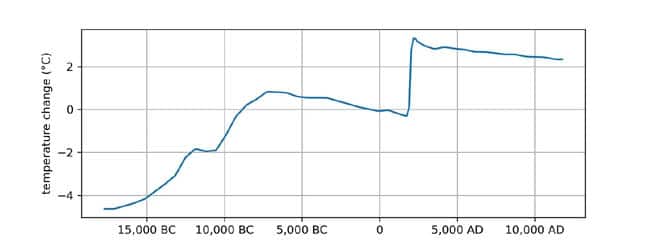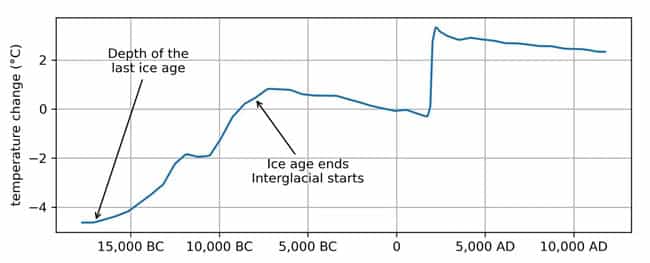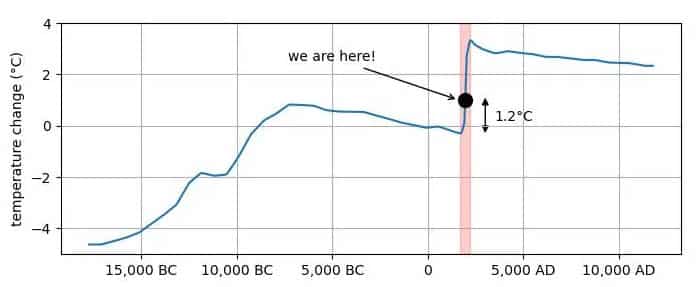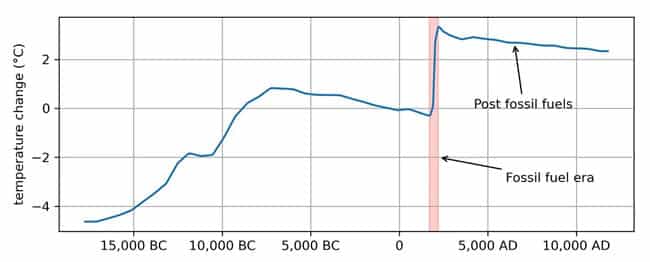THE SCARIEST CLIMATE PLOT IN THE WORLD
by Andrew Dessler
When I give talks about climate change, I start with one particular plot that encapsulates the gravity of our current climate trajectory more starkly than any other I’ve found. I call it the scariest plot in the world:

adapted from Clark et al., Consequences of twenty-first-century policy for multi-millennial climate and sea-level change. Nature Climate Change, 6, 2016, doi:10.1038/nclimate2923
To understand why this plot is so scary, let’s go over what it tells us about past and future climate change.
A journey through 30,000 years
The plot shows the evolution of the climate, starting 20,000 years ago and ending 10,000 years in the future:

The plot begins in the depths of the last ice age, generally referred to in the climate biz as the Last Glacial Maximum. Temperatures then warmed until the ice age ended 10,000 years ago. This is the beginning of the Holocene, the warm and pleasant interglacial period we are now experiencing, characterized by a warm and stable climate that has allowed human civilization to flourish.
The fossil fuel era: A brief spark that causes lasting burns
The trajectory of our climate takes an abrupt detour starting around 250 years ago, coinciding with the dawn of the Industrial Revolution. This is the fossil fuel era — the pink band on the plot. In the grand tapestry of human history, the fossil fuel era will be a brief spark, spanning just a few centuries, yet the repercussions of this period are immense. During the few centuries that we’re burning fossil fuels, we are projected to warm the climate around 3°C given current climate policies.
When the era of fossil fuels eventually ends, whether due to depletion or a concerted shift to sustainable energy sources, the climate will not quickly revert to its pre-industrial state. Rather, the consequences of our brief but intense carbon outburst will linger, with temperatures elevated for 100,000 years.
This is one of the most troubling aspects of climate change: The decisions we make in the next few decades will determine the climate for the next 5,000 generations. If we choose unwisely, people in the future will justifiably be furious with us because we know what we’re doing but we’re doing it anyway.
3°C is bad news
If you think 3°C of warming sounds inconsequential, you’re wrong. Your opinion is based on your personal experience with local temperatures, which do indeed vary a lot. But the global average temperature is very stable, so a 3°C shift is monumental.
We can see evidence for this in the plot above. The last ice age, with colossal ice sheets covering large parts of the Northern Hemisphere continents and sea level 300 feet lower than today, was about 5°C cooler than today. Thus, warming of 3°C is 60% of the temperature change that transitioned us from an ice age into an interglacial. 3°C will literally reformat the surface of the Earth.
Already feeling the heat

And given the non-linear nature of climate impacts, the next increment of warming will be a lot worse than the last one.
But don’t despair, our future is not yet set in stone. We still largely control the fate of our climate. But not for long. If we want to avoid the clear disaster that 3°C of global-average warming represents, we need to address the problem now.
The good news is that we don’t need a magical solution. The challenge of climate change is not rooted in science or technology. We know how to solve this. Rather, it’s a political issue. What we lack is a collective decision to confront and manage this risk. Fortunately, this is something we can solve at the ballot box.
Andrew Dessler is Professor of Atmospheric Sciences & climate scientist at Texas A&M, and Director of the Texas Center for Climate Studies. Reposted, with permission, from The Climate Brink, November 14, 2023.





